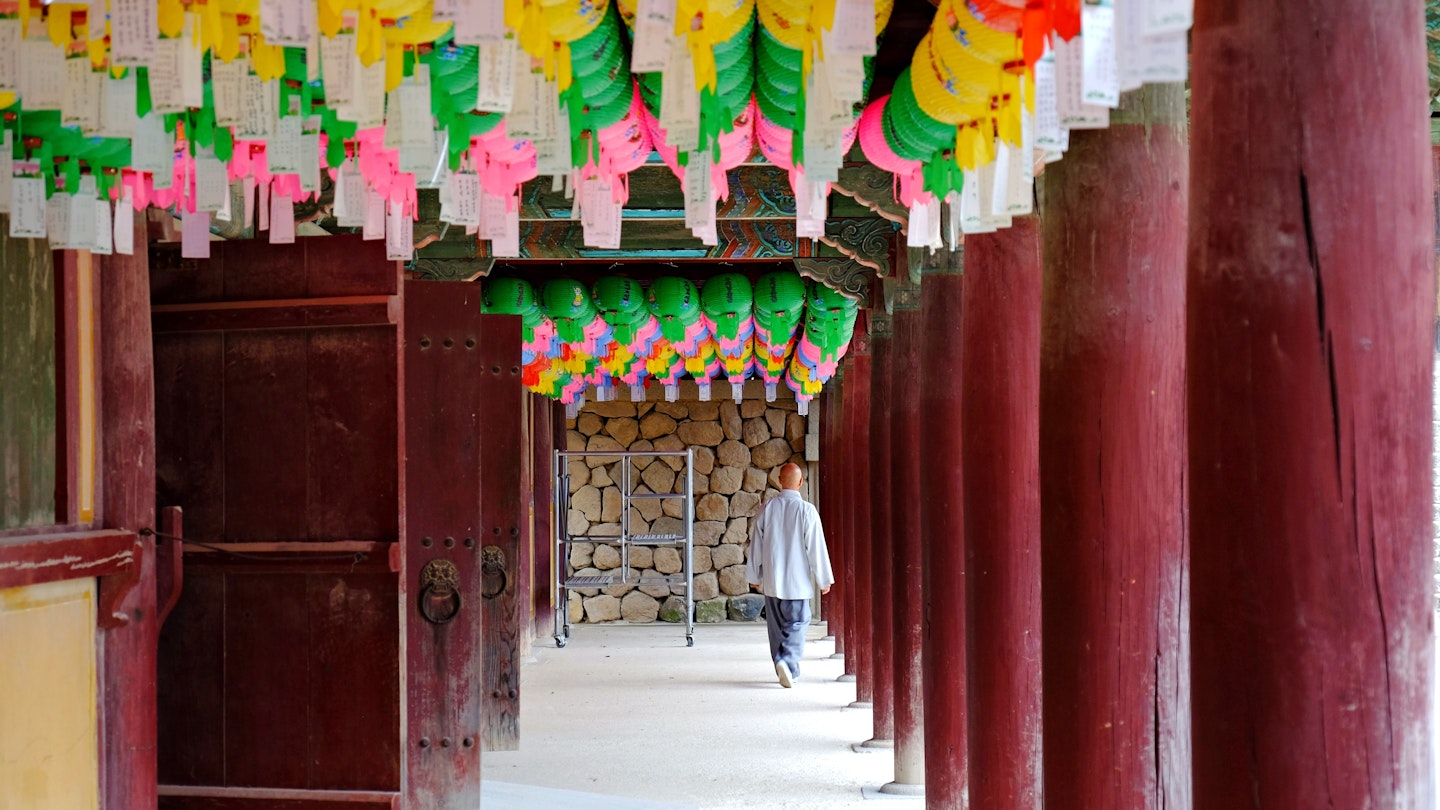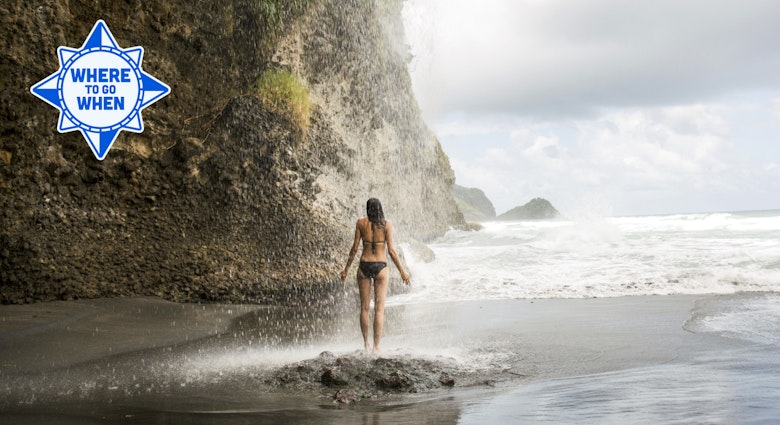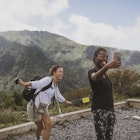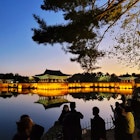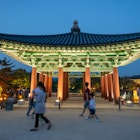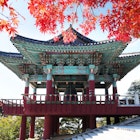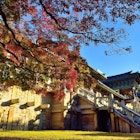At first sight, Gyeongju seems so vast as to require a guided tour. Yet the many sights in this historic, gracious city are remarkably easy to navigate on your own.
A visitor-friendly bus provides a ready-made hop-on, hop-off itinerary. And most attractions are clustered together, allowing you to stroll, cycle and meander around traffic-free zones in this “museum without walls.” Here are our tips for how to get around Gyeongju.
Take it easy with room to discover by taking a loop bus
Two buses ply one circular route that connects the major sights in central Gyeongju, making this a fuss-free way to see everything without the burden of too much planning. It also leaves room for spontaneity: hop off when something grabs your attention – say, a particularly picturesque group of tumuli burial mounds, or autumn maples in an appealing shade of red.
Both buses 10 (the clockwise loop) and 11 (counterclockwise) run from Gyeongju’s adjacent bus terminals (Gyeongju Express Bus Terminal and Gyeongju Intercity Bus Terminal) and Gyeongju train station to the lofty stone temple Bulguk-sa. Rides cost ₩1650 ($1.38) regardless of distance; sadly, there are no transfer discounts for the same route. Each stop (with its adjacent sights) is announced in Korean and English, although the route map on board is only in Korean. Buses run every 20 minutes from 6am to 9:40pm.
Bus 10 provides the most direct route to the astronomical observatory Cheomseongdae and Lake Bomun Resort. Bus 11 is the faster choice for getting to Donggung and Wolji Pond (also known as Anapji Pond), Gyeongju National Museum and northeastern Namsan. From Bulguk-sa, the fastest bus to the sights will be vice versa, so bus 11 will pass through Lake Bolmun Resort, and so on.
From Bulguk-sa bus 12 takes you up to Seokguram. If you want to see it all, plan the timing of your itinerary based on the route taken by bus 10 or 11. Keep in mind that routes 10 and 11 can be standing-room-only on busy weekends, so it might be useful to seek alternate local bus routes if this is your preferred mode of transit.
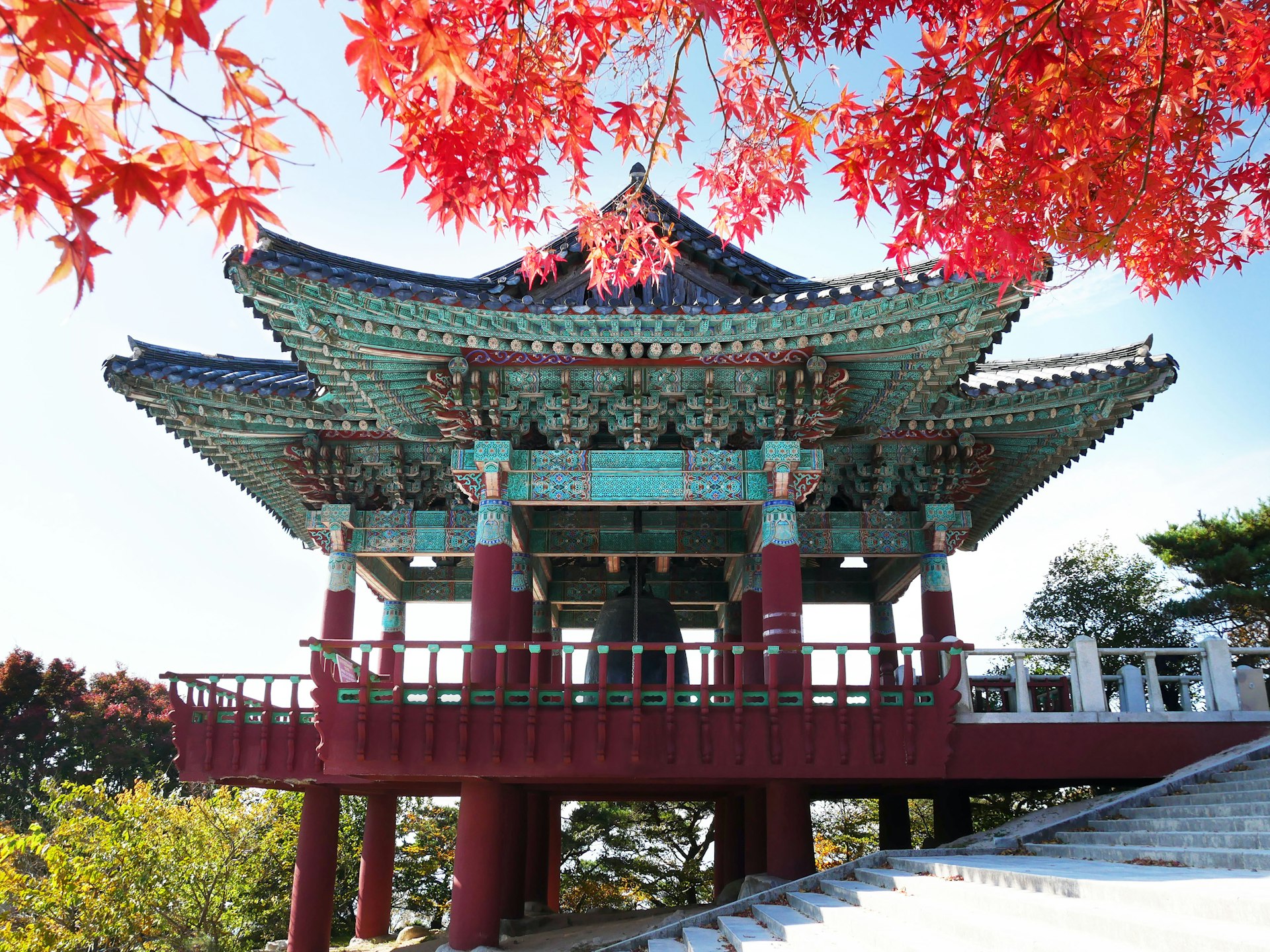
Tailor your visit using local buses
You can take a local bus to most of Gyeongju’s other sights without a guide or tour. From the center of town, local buses 61 and 60 can get you to nearby Tumuli Gongwon; buses 500 and 506 head west toward Namsan; and tourist bus 100 departs toward the east. Bus 203 takes you to Yangdong Folk Village from Gyeongju station (and, infrequently, Singyeongju station) in 45 minutes. Bus 700 runs directly between the bullet-train station at Singyeongju (with KTX trains from Seoul) and Bulguk-sa in 55 minutes, stopping along the way at sights like Wolji Pond and Lake Bomun Resort. A map on board lists each stop in English. One bus ride costs ₩1250 to ₩1650 ($1.05-$1.38), regardless of distance.
In South Korea, Naver and Kakao Maps are the best for digital-routing options. Kakao shows the best bus to catch and can be navigated using English names; familiar icons make route options legible to non-Korean speakers. Internet access is required.
Get a transport pass
You can pay your fare on Gyeongju buses throughout the network using either of two rechargeable IC e-cards. The more popular option is T-money (also used in Seoul and across South Korea); Mybi (from Busan; it also works in Seoul) is also accepted. Though you can recharge the cards at convenience stores like the CU store at Gyeongju Station, we recommend topping up the card before you arrive so you can hop right on the bus.
While the cards only offer slight discounts on travel for most visitors (paper tickets cost ₩50 on top of the prices listed here), they make travel more convenient by avoiding the hassle of having to buy paper tickets. The cards are also useful for buying food and drinks from the same convenience stores that offer preloaded credit.
Maximize your time with a taxi by the ride or the half-day
Taxis in Gyeongju are metered, affordable and easy to hail from the street. They are useful for short trips when you just want to get there, as well as for groups. A taxi ride also works well if you want to see places not covered by buses 10 and 11.
The 5-minute ride between Gyeongju Station and Gyeongju National Museum will cost about ₩3500 ($2.93, only a little more than two tickets on bus 11). A one-way ride between Lake Bomun Resort and the city center runs about ₩10,000 ($8.38). You will see taxis outside train and bus stations touting their services for half a day – you can consider this a private tour, though one without a guide. You can haggle with a smile, but still expect to pay about ₩150,000/200,000 ($125.71/$167.61) for 5/7 hours.
Walk through an open-air museum
It should be no surprise that strolling in the open air is one of the best things to do in a “museum without walls.” Indeed, the Tumuli Gongwon historic area that covers 23 burial mounds, former royal gardens and an ancient astronomical observatory is simply a joy to discover on foot. High-rises are banned here, so if you are coming from a city, you’ll find it refreshing to be able to gaze into the distance. If you stay in the center of town, you can really burn some calories by walking to this nearby area, and then to the hip cafes of Hwangridan-gil afterward, without having to set foot in a vehicle.
Since the Lake Bomun Resort is geared towards domestic visitors, and since Koreans like to walk, you’ll find plenty of fellow strollers around the lake, in the theme park and shopping areas, and under the cherry blossoms.
A network of trails trace the mountainsides of Namsan and the pagodas, Buddha statues and more make this walk a delightful scavenger hunt set in nature.
The incline between Bulguk-sa and the Buddha at Seokguram takes only 20 minutes on a (frequently late) bus – but it’s an invigorating 1.5-hour hike in the fresh air, with smells of pines and blossoming flowers. Bulguk-sa was designed to incorporate terraces made for walking, and it was believed that you could enter the world of Buddha by passing through its wooden gates. At the end of a forested path, a giant Buddha effigy is sheltered in the cave of Seokguram. Perhaps counterintuitively, we recommend walking uphill to let your excitement build, followed by a bus ride down.
Explore Gyeongju by bicycle
Gyeongju is ideal for exploring on two wheels. The historic area around the royal tombs of Tumuli Gongwon is especially pleasant and easy to get around. The distances are fairly significant, but they’re not strenuous and there is little traffic. You can rent bikes almost anywhere, especially outside bus and train terminals; expect to pay about ₩4000/15,000 ($3.35/$12.57) per hour/day for a regular bicycle. In South Korea, electric-assisted bicycles have been allowed to use bike paths from mid-2018, and they are starting to trickle into Gyeongju alongside electric scooters.
The Kakao Maps app shows you what percentage of a route is on cycle paths, how many intersections and bridges must be crossed, and how steep the route is. The cycling estimate for the 14.8km (9 miles) from the city center to Bulguk-sa is about 1 hour across 11 intersections.

Why cycling is my favorite way to travel in Gyeongju
Freedom. A bus and taxi might get me to the historic areas, but as a cyclist, I can spot a patch of pink muhly grass in the distance then head straight there with some vigorous pedaling. More than mere transport, a bike ride is part of the experience of exploring the wide spaces of Gyeongju – and an especially easy one, if you choose central accommodation that includes free bike hire.
Gyeongju has plenty of flat cycling paths through blossoming fields and village rice paddies that can make one feel like a local wheeling between errands. One day I might even get to live out my K-drama fantasies of pedaling between the rolling green tumuli on a tandem bicycle with my sweetheart and a giant map. In the meantime, I’m convinced that one afternoon of cycling around Gyeongju makes up for snacking on a dozen servings of sweet red-bean Gyeongju bread along the way. It’s what the Silla royalty would have wanted.
Drive around by car
Even if you arrive in Gyeongju in a rental car, you’ll likely find that it’s more convenient to walk between the main sights in the center of town. (Note that rental cars might have GPS only in Korean, and there is no need to rent a car once you’ve arrived.) There are public parking lots around Namsan and the major sights.
A similar and more economical option is to hire a taxi for the day. If you do want to hire a car, ask at your hotel or around the bus and train terminals.
Accessible transportation in Gyeongju
Though Gyeongju may sprawl, most clusters of sights are relatively wheelchair accessible. The biggest challenge will likely be getting there: local buses do not “kneel” or have space for a wheelchair, while wheelchair-accessible taxis cater mostly to residents. That limits options to tours geared toward accessibility, such as Korea Wheelchair Tour.
Once at the major sights, you’ll find paths for wheelchairs and baby strollers; the historic area around Tumuli Gongwon an especially lovely network of paths. Even Bolguk-sa is wheelchair- and baby-stroller-accessible (with free rentals, too), though you will be restricted to the lower level.
Regrettably, Gyeongju offers few facilities for visitors with vision impairment.
Find out more on Lonely Planet’s accessible travel resource page.
You may also like:
16 top things to do in Gyeongju, from tombs to tasty treats
The endangered royal dogs of Gyeongju
How Gyeongju has become South Korea's city of cool

